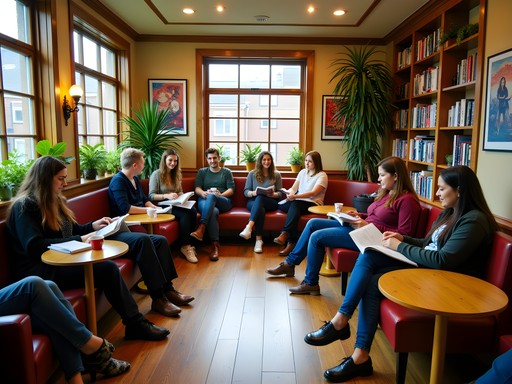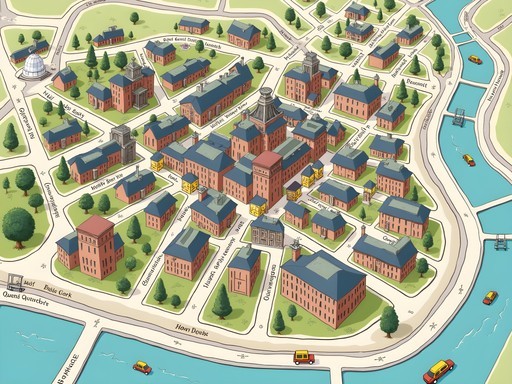Disclosure: This article contains affiliate links. We may earn a commission from purchases at no extra cost to you, which helps our travel content.
Standing before a three-story mural depicting a masked gunman, I felt the weight of Belfast's troubled history pressing against my chest like a heavy manuscript. Just minutes later, around a corner in the Cathedral Quarter, I found myself smiling at a vibrant, abstract piece that could have been at home in Brooklyn or Berlin. This is Belfast in microcosm – a city where street art serves as both historical document and contemporary expression, where paint on brick tells stories of division and healing in equal measure. As someone who spent two decades editing other people's stories, I've developed an eye for narrative threads that weave through seemingly disparate elements. Belfast's walls offer precisely this: a visual anthology of its complex past and hopeful present, accessible to anyone willing to walk its streets with open eyes and an open heart.
Understanding Belfast's Dual Art Narrative
Belfast's street art exists in two parallel worlds that occasionally intersect like chapters in a well-crafted novel. On one hand are the political murals – powerful, provocative works dating back decades that chronicle The Troubles through loyalist and republican perspectives. On the other are the contemporary pieces transforming neglected spaces into vibrant galleries, often deliberately apolitical yet unmistakably shaped by the city's history.
My journey into understanding this duality began years ago while editing a photographic essay on conflict zones for National Geographic. Those images of Belfast's political murals stayed with me – stern-faced paramilitaries, commemorations of hunger strikers, and territorial markings that functioned as visual borders between communities. What those photographs couldn't capture was the emotional resonance of standing before these works, how they command attention and respect regardless of your political leanings.
The political murals primarily cluster in two areas: the loyalist Shankill Road (predominantly Protestant neighborhoods supporting union with Britain) and the republican Falls Road (predominantly Catholic areas supporting a united Ireland). Walking between these areas today, you'll cross the Peace Line – a series of barriers separating communities that, despite the 1998 Good Friday Agreement, remain largely segregated. The contrast between these areas and the city center's contemporary street art scene provides a perfect lens through which to understand Belfast's ongoing evolution from conflict zone to cultural hub.

💡 Pro Tips
- Join a Black Cab tour for context on political murals – local drivers often have personal connections to The Troubles
- Visit both loyalist and republican areas to understand different perspectives
- Look for recurring symbols: King William of Orange and Queen Elizabeth in loyalist areas; Celtic imagery and hunger strikers in republican neighborhoods
The Political Murals: Walking Through Living History
My exploration began with a Black Cab tour – an experience I cannot recommend highly enough for first-time visitors. My driver, Tommy, grew up during The Troubles and offered perspectives no guidebook could provide. At £35 for a 90-minute private tour, it's worth every penny for the contextual understanding it provides. I complemented this with a self-guided walking tour the following day, using my pocket guidebook to navigate between key sites.
On the Shankill Road, loyalist murals celebrate British identity through depictions of the Queen, Union Jack flags, and commemorations of paramilitary fighters. The most striking feature uniformed men in balaclavas pointing guns directly at viewers – an unsettling experience that Tommy explained was intentional: "These weren't just decorations; they were warnings about who controlled the territory."
Just a short walk away but separated by the Peace Wall, Falls Road presents republican narratives through murals honoring hunger strikers, depicting Celtic imagery, and expressing solidarity with other global struggles like Palestine and Catalonia. The International Wall, with its constantly changing artwork addressing human rights issues worldwide, demonstrates how republican murals in particular have evolved to connect local experiences to global movements.
What struck me most was how these murals function as outdoor history books, continuously edited and updated to reflect changing political realities. Some of the most aggressive imagery has been replaced with more community-focused pieces, though plenty of provocative work remains. Standing before a memorial to fallen IRA volunteers, I watched as local children rode past on bicycles, completely unfazed by imagery that had me reaching for my pocket notebook to capture my thoughts on this normalization of political imagery.

💡 Pro Tips
- Respect these areas as residential neighborhoods, not just tourist attractions
- The murals change regularly – some famous ones may have been painted over
- Avoid wearing clothing with obvious political affiliations (certain soccer jerseys can be problematic)
The Cathedral Quarter: Belfast's Street Art Renaissance
If the political murals represent Belfast's complex past, the explosion of street art in the Cathedral Quarter embodies its creative future. This neighborhood, once neglected, has transformed into the city's cultural heart through organic artistic development and deliberate regeneration efforts.
My exploration began at The MAC (Metropolitan Arts Centre), where I oriented myself before venturing into the surrounding alleyways. Commercial Court and Hill Street host the highest concentration of pieces, with new works appearing regularly. Unlike the political murals, which often follow established visual languages and themes, these works showcase diverse styles from photorealism to abstract expressionism.
The annual Hit the North festival has been instrumental in this transformation, inviting international artists to paint alongside local talents. The result is a neighborhood that feels simultaneously distinctly Belfast and cosmopolitan – much like the city itself as it continues to redefine its identity in the post-Troubles era.
What makes this area particularly appealing for budget travelers is its accessibility. I spent an entire morning wandering these streets with nothing but my camera and a coffee from Established (a local favorite with excellent pour-overs). The juxtaposition of centuries-old architecture with contemporary art creates a uniquely Belfast aesthetic that I found myself trying to capture from every angle with my camera lens, which proved perfect for the narrow alleyways and variable lighting conditions.
Most compelling was finding pieces that subtly bridged Belfast's dual art narrative – contemporary works that referenced historical themes without being explicitly political. A massive mural of two children reaching across a divide spoke volumes without saying a word about politics.

💡 Pro Tips
- Visit during weekday mornings for empty streets that make photography easier
- The Duke of York pub area has some of the most photographed pieces
- Check with The MAC for information about any recent additions or guided tours
Beyond the Center: Emerging Art Districts
While the Cathedral Quarter receives most attention, Belfast's street art ecosystem extends well beyond this central hub. East Belfast, traditionally a loyalist area, has seen a remarkable artistic renaissance in recent years. The EastSide Visitor Centre provides maps for self-guided tours of murals that reflect the area's industrial heritage, particularly the Harland & Wolff shipyards where Titanic was built.
The Seedhead Arts organization has been instrumental in developing these emerging districts through their Street Art Walking Tours (£15 per person, running on Sundays). Unlike the politically-focused Black Cab tours, these excursions emphasize artistic techniques, international influences, and the stories behind individual artists.
During my weekend exploration, I ventured to North Belfast's New Lodge area, where community-led initiatives have transformed once-bare walls into powerful statements about local identity. Here, traditional political imagery sometimes merges with contemporary street art styles, creating fascinating hybrid works that document a city in transition.
What struck me most was how these emerging districts use street art differently than either the traditional political areas or the Cathedral Quarter. In these neighborhoods, murals often address hyperlocal concerns – celebrating community heroes, commemorating local history, or addressing issues like mental health that particularly affect post-conflict societies.
For photographers, these less-visited areas offer opportunities to capture authentic interactions between artwork and everyday life. I found myself documenting not just the murals but the contexts surrounding them – children playing football beneath massive portraits, elderly residents sitting on benches before vibrant scenes, the juxtaposition of ordinary life against extraordinary art. My portable tripod proved invaluable for capturing low-light evening shots when the murals take on new dimensions under street lighting.

💡 Pro Tips
- Contact community centers before visiting residential areas outside the city center
- The EastSide Visitor Centre offers free walking maps of East Belfast murals
- Some emerging art districts are best visited with local guides who understand neighborhood dynamics
Practical Tips for Street Art Explorers
Belfast's compact size makes it ideal for a weekend exploration, but navigating between different areas requires some planning. I structured my weekend chronologically – starting with the historical political murals to understand the context, then moving to contemporary works that respond to that history.
Day 1: Historical Context - Morning: Black Cab tour of political murals (book in advance) - Afternoon: Self-guided walking tour of Falls Road and Shankill Road - Evening: Visit the Peace Wall at sunset when the light creates dramatic shadows
Day 2: Contemporary Scene - Morning: Cathedral Quarter exploration (start early for empty streets) - Afternoon: Seedhead Arts walking tour or East Belfast murals - Evening: North Belfast emerging art districts
While Belfast is generally safe for tourists, some sensitivity is required when visiting areas with political murals. I found locals incredibly welcoming but appreciated having researched the basic historical context beforehand. The city's compact size means public transportation works well, though I primarily explored on foot.
For accommodation, I stayed at a budget-friendly Airbnb near Queen's University, which positioned me equidistant from the main areas I wanted to explore. Food costs were reasonable – about £15-20 for a nice dinner, with plenty of budget options around £8-10 for lunch.
One final tip: Belfast's weather is notoriously changeable. I experienced sunshine, overcast skies, and rain showers all within hours. My packable rain jacket became my constant companion, allowing me to continue exploring (and importantly, photographing) regardless of conditions. The changing light actually enhanced many of the murals, particularly the way rain-slicked streets reflected the vibrant colors.

💡 Pro Tips
- Download offline maps as some areas have spotty mobile coverage
- Carry cash for small businesses in residential areas
- Consider the 'hop-on, hop-off' bus for an initial orientation before exploring specific neighborhoods in depth
Final Thoughts
As my weekend in Belfast drew to a close, I found myself reflecting on how street art functions as both mirror and window in this resilient city – reflecting its complex history while offering glimpses into its potential futures. The political murals stand as necessary reminders of conflicts not fully resolved, while the contemporary pieces suggest possibilities beyond division. For the solo traveler seeking to understand Belfast beyond superficial tourism narratives, these painted walls offer an accessible, budget-friendly education in history, politics, and artistic expression. Like any good editor, Belfast is continuously revising its story – painting over certain passages, emphasizing others, adding new perspectives. The privilege of witnessing this ongoing revision, brush stroke by brush stroke, is available to anyone willing to walk these streets with curious eyes and comfortable shoes.
✨ Key Takeaways
- Belfast's street art exists in two parallel worlds: historical political murals and contemporary urban expression
- Black Cab tours provide essential context for understanding the political murals and their significance
- The Cathedral Quarter represents Belfast's artistic renaissance and optimistic future
- Emerging art districts in East and North Belfast show how communities are using art for hyperlocal expression
📋 Practical Information
Best Time to Visit
May through September for best light and weather conditions
Budget Estimate
£150-250 for a weekend (accommodation, food, tours)
Recommended Duration
2-3 days
Difficulty Level
Moderate (Some Navigation Between Different Neighborhoods Required)
















Comments
bluelover
Those political murals look intense! Do they change them often or are they preserved as historical pieces?
winterzone
Great post! Did you make it to the emerging art district you mentioned? Wondering if it's worth extending my stay to check it out.
Leah Clark
Yes, I spent half a day in the East Belfast area! It's less concentrated than the Cathedral Quarter but has some amazing pieces and feels very authentic. Definitely worth it if you have an extra day.
Sarah Powell
Excellent analysis of Belfast's dual art narrative, Leah. I was there last month researching for my own piece on post-conflict tourism. What struck me was how the political murals function almost as living museums, while the Cathedral Quarter art feels like it's actively creating Belfast's future identity. I found the Belfast Street Art Walking Map incredibly helpful for self-guided exploration of both areas. Did you notice how many locals engage with the newer art versus the political pieces? I found that fascinating to observe.
luckyblogger
I visited Belfast last spring and was equally moved by the murals. That stark contrast between the political pieces and the vibrant new art in the Cathedral Quarter really tells the story of a city in transition. Did you try the Black Cab tour? Our driver was an ex-political prisoner who shared some incredibly personal stories that added so much depth to the experience.
winterzone
I did the Black Cab tour too! Our guide grew up during The Troubles and had some heartbreaking stories. Definitely worth it.
skygal4210
This looks amazing! Is it safe to wander around these areas solo? Planning a trip in January and wondering if I should book a tour instead.
Leah Clark
Absolutely safe during daylight hours! For the political murals, I'd recommend a guided tour anyway - the context they provide is invaluable. The Cathedral Quarter is perfectly fine to explore independently anytime.
skygal4210
Thanks so much! Will look into booking a tour then.
wavezone4427
Wow, what a powerful post! Those political murals are something else. Thanks for sharing both sides of Belfast's art scene!
redtime
That shot of the peace wall is stunning. The contrast of the barbed wire against the colorful art says everything about Belfast.
roamguy
Wow! Never considered Belfast for a city break but this has totally changed my mind! Booking flights now!
wildrider
Do it! I was surprised how much I loved Belfast. The food scene is amazing too!
Megan Martin
Excellent coverage of Belfast's evolving art scene, Leah. I've visited three times in the past two years for work, and each time I discover something new. For anyone planning a visit, I highly recommend scheduling your Cathedral Quarter exploration for evening hours when the pubs are lively and the street art takes on a different character under the lights. Also, many locals are incredibly willing to share stories about the murals if you express genuine interest - some of my most memorable conversations have happened this way. The juxtaposition of historical trauma and creative renaissance makes Belfast one of the most fascinating urban landscapes in Europe right now.
luckymood
Great post! I'm visiting Belfast next month with my teenage kids. Do you think the political murals would be too intense for them? They're 14 and 16. Also wondering if there are specific areas in the Cathedral Quarter you'd recommend focusing on if we only have a few hours?
redseeker
Not OP but I took my 15-year-old last year. The murals are powerful but I think they're important for teens to see. It sparked really good conversations about conflict resolution and peace. For Cathedral Quarter with limited time, focus on Commercial Court, Hill Street and Kent Street - highest concentration of colorful pieces in a walkable area!
luckymood
Thanks so much for the advice! That's really helpful. We'll definitely check out those streets.
Venture X
Premium card with 2X miles, $300 travel credit, Priority Pass